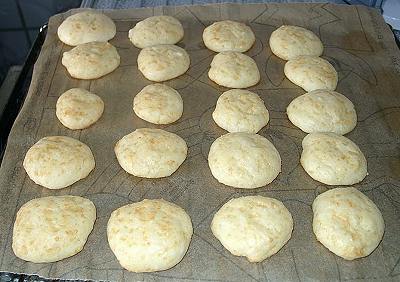Brotkasten | Brotrezepte
| Links | Brot-Bücher
| Kochkiste | Gästebuch
![]()
Brotkasten | Brotrezepte
| Links | Brot-Bücher
| Kochkiste | Gästebuch
![]()

========== REZKONV-Rezept - winREZKONV v1.55.p8
Titel: Pao de Queijo #5
Kategorien: Gebaeck, Brot, Kaese, Brasilien
Menge: 1 Rezept
1/2 Tasse/n Pflanzenoel
1/3 Tasse/n Wasser
1/3 Tasse/n Milch
1 Teel. Salz; nach Belieben
200 Gramm Tapiokastaerke
2 Eier
170 Gramm Hartkaese; gerieben, z.B.
-Parmesan
======================QUELLE======================
-WWW
-s.u.
-Erfasst *RK* 22.04.02 von
-Petra Holzapfel
Den Backofen auf 190GradC vorheizen.
Oel, Wasser und Milch aufkochen. Diese Mischung zur Tapiokastaerke
geben. Mit einem hoelzernen Loeffel gut mischen und etwa 15 Minuten
quellen lassen. Man erhaelt eine weissliche Masse. Mit 2 Eiern und
dem geriebenen Kaese mischen. Die Masse ist zaeh und klebrig.
Mit einem Loeffel walnussgrosse Stuecke abstechen und mit geoelten
Haenden kleine Baellchen formen, auf ein mit Backpapier ausgelegtes
Backblech setzen.
15-20 Minuten backen, bis die Oberflaeche beginnt, braun zu werden.
Die Baellchen laufen beim Backen etwas auseinander.
"Pao de queijo is extremely simple to make. Instead of wheat flour,
tapioca starch is used. It's available from any oriental grocery
store. One bag is enough for two batches, cost about $0.69. a bag.
Care must be taken not to confuse this with the "fish eyes" tapioca
(little white beads) available at American stores.
Working with tapioca starch is a lot like working with glue. Dry, it
has the consistency of cornstarch. Wet, the tapioca starch is
extremely gooey. It comes from the manioc plant which is heavily
used in tropical areas not cool enough to grow wheat.
Many cheeses can be used for pao de queijo, as long as it is hard
and can be finely grated. You can used cheeses like parmigiano
reggiano, various Italian granas (like reggianito), Sardo (an
Argentinian parmesan), domestic parmesan including Kraft in the
green can, and even Provolone. You may have to vary the amount of
cheese according to how salty it is. My motto: err on the side of
too much cheese!
After you make pao de queijo a few times, you'll develop certain
preferences. For instance, I like them lightly browned, hot from the
oven, when the skin is delicately crispy and the inside is gooey. On
the other hand, some prefer them darker so that the crust is thicker,
or cooled so that the inside is porous. You can also make them
larger and use them like a dinner roll. For a dinner-size roll,
you'll either have to add a little more tapioca starch to make the
dough stiffer (easier to form the larger balls and will hold its
shape better when baking) or use muffin tins.
I can whip up a batch in 30 minutes, including baking (and skipping
the dough's rest period). People usually can't stop eating them
until they're gone. They are fun to make and fun to eat. They go
especially well with wine and with coffee."
http://www.cs.uiuc.edu/people/staff/tolliver/pdq.html
Anmerkung Petra: Bei mir war der Teig so weich, dass ich gar keine
Kugeln formen konnte, ich habe mit 2 Teeloeffeln kleine Haeufchen
auf das Blech gesetzt. Geschmacklich sehr gut! Aehneln von der Form
her allerdings eher kleinen Fladen. Zur besseren Formhaltung
entweder mehr Tapiokastaerke verwenden oder den Teig in Mini-
Muffinformen setzen.
=====